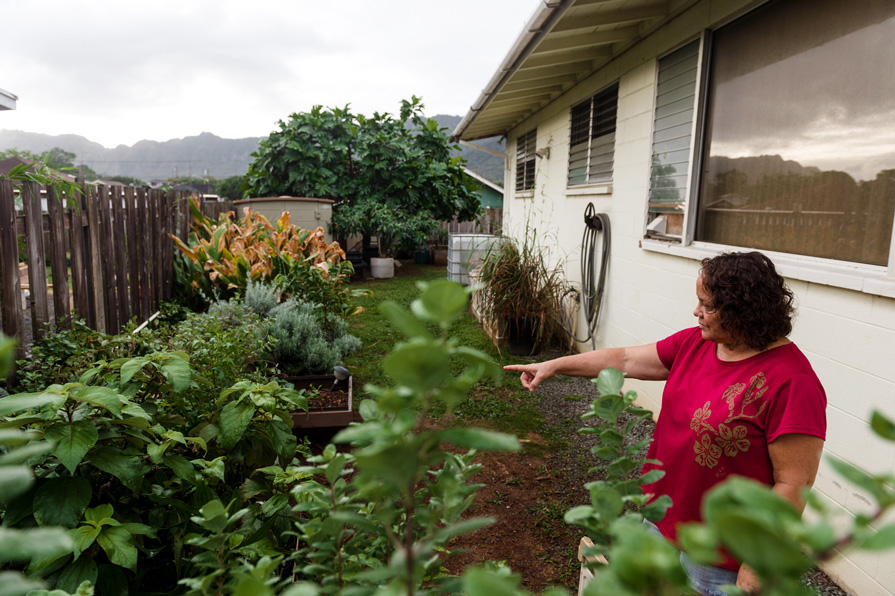Images by John Hook
In the home garden of Leinā‘ala Bright are more than 30 varieties of what she calls her mo‘opuna, or grandchildren. Red conical heads of ginger bob among a hedge of green; nodules of ruddy turmeric roots await harvest. “They’re like my family,” Bright says of the mea kanu, or plants.
A practitioner of Hawaiian herbal medicine, known as lāʻau lapaʻau, Bright utilizes each of the plants in her garden as her kūpuna once did by planting and harvesting according to the kaulana mahina, or Hawaiian moon calendar, to make poultices, herbal oils, salves, tinctures, and teas.
Bright began her journey as a healer 26 years ago. Her mother, a nurse, used various homeopathic remedies to heal her family at home. Many of her relatives were skilled lomilomi practitioners, and she obtained a massage license in her early 30s. But after 10 years of healing others through massage, she felt a desire to heal herself through education by deepening her knowledge of culture and the connections between land and health. Bright earned a master’s degree in Hawaiian Studies from Kamakakūokalani Center for Hawaiian Studies at University of Hawai‘i at Mānoa, where she studied under master lāʻau lapaʻau practitioner Levon Ohai, who passed away in 2012. She also conducted aquaponics research at the university’s College of Tropical Agriculture and Human Resources.

Working with the land, Bright discovered how to propagate both the endemic and non-native plants she used in her research studies, such as māmaki, pōpolo berry, and her personal favorite, ‘ōlena (Hawaiian turmeric). “‘Ōlena is so strong for the immune system,” says Bright, who was able to coax high yields of curcumin, the active ingredient that gives turmeric its anti-inflammatory and anti-cancer properties. “Even in the medical world, they are dosing it for cancer,” she explains. “I’m currently working with a few patients in my personal practice with cancer, so I have them on an anti-inflammatory diet while taking ‘ōlena.”
In 2009, Bright partnered with David McGuire to establish NaloPonics, a company that creates home aquaponics systems, where kalo, leafy greens, and healing plants such as ‘ōlena, māmaki, and chili pepper can thrive. Incorporating the “food as medicine” movement into her practice, Bright hopes to teach others how to cook with these important plants as well. The healing properties of herbs are maximized through traditional methods of extraction, such as drying, juicing, or boiling. “Our tūtū had medicine gardens—they called them weed gardens,” she says with a laugh. “My job now is to reawaken those memories and practices so that they continue.”

Bright infuses those traditions with modern medicine as the cultural health prevention specialist at Waimānalo Health Center, where she began working in 2015. Practitioners before her have utilized lomilomi massage for healing in the healthcare industry, but to her knowledge, Bright is the first lāʻau lapaʻau practitioner fully integrated into primary care at Waimānalo Health Center. She offers holistic healthcare alternatives in the forms of lāʻau lapaʻau and lomilomi, treating patients with chronic pain and illnesses, such as diabetes, cardiovascular problems, and even cancer. “Waimānalo [Health Center] is perfect because I’m given the opportunity to heal, but also to teach,” she says. “I make teas, salves, bring plants in, and send them home with patients to nurture and heal themselves.”
While she brings lāʻau to patients at the clinic on an as-needed basis, she also sees patients at home in Waimānalo several evenings a week, where she calls on the backyard pharmacy she has cultivated with her own two hands. These plants have become as much a part of her as they are a part of her practice. In tapping into the traditions of her kūpuna, while understanding the connection to land and spirit, Bright heals from seed to soul. “It’s not only the ingesting of that lāʻau,” she says, “but about raising that lāʻau so that it becomes a part of your family.”

